ABOUT AUTHORS
Diksha A. Narwade*, Dr. A. N. Aher
Department of Pharmacognosy,
MVP samaj college of pharmacy,
Gangapur road Nashik, Maharastra, India
{ DOWNLOAD AS PDF }
ABSTRACT
This paper gives the information about the Annona squamosa Linn. (Family: Annonaceae). Phytochemical and pharmacological studies of medicinal plant were performed. The plant is highly used traditionally for curing diverse diseases and disorders. It is locally known as “Sitaphal'' in Hindi. Macroscopical & microscopical studies of leaves have been studied. The phytochemical studies showed the presence of amino acids, terpenes, lipids, steroids, flavonoids, ascorbic acid, tannins, vitamins and alkaloids. The plant has various pharmacological actions such as insecticidal, purgative, laxatives, astringent, anti-inflammatory, antidiabetic, anti-ulcer, anti-oxidant, antimalarial and antibacterial. The reveiw specifically deals with the phytochemical and folkloric medicinal importance of plant.
Reference Id: PHARMATUTOR-ART-2635
INTRODUCTION (Pandey N et al ., 2011)
There are 70 species of Annona genus out of them three fruit bearing plants were Annona squamosa, Annona reticulata, Annona muricata. The three species were identified by morphological characters.
1. Fruit tubercled - Annona squamosa
2. Fruit smooth slightly aveolate - Annona reticulata
3. Fruit bearing numerous fleshy spines-Annona muricata
Annona squamosa is second largest genus of flowering plant in the family of Annonaceae is medium sized small, evergreen, cultivated in various parts of India and it is native from West Indies and America.
According to World Health Organization, 80% of population living in developing countries mostly depend on traditional medicines for curing diseases & primary health care needs.
Literature survey of many researcher shows that every part of plant has its folkloric medicinal importance. It is considered beneficial for cardiac disease, diabetes, hyperthyroidism, cancer, ulcer, wounds, etc. The review has been reported to contain chemical moieties like alkaloids, tannins, terpenes and resins.
HISTORY OF SITAPHAL:
History of herbal medicines starts from human advancement. The documents plants which are of great importance in ancient past, evidenced that plants were used traditionally for medicinal purpose in China, India, Egypt and Greece far before the beginning of Christian era. (Sandeep et al., 2017)
This fruit has an interesting imaginary history adhering to it with respect to its common name i.e. Sitaphal. Mythologically it is said that, wife of Lord Rama i.e Sita, during her vanvaas used to eat this fruit. While another story says that during those days of vanvaas Ravana was abducting Sita, at that time the drops of her tears from her eyes gets falling on the ground and they gave birth to Stephan trees in the wilderness. Its origin is in Sanskrit i.e “sheet” in hindi means cold and “phal” is fruit and having excess of it can give you cold and also it has cooling effect on our body so the name “Sitaphal” is given. (Kaur R et al., 2015)
TAXONOMICAL CLASSIFICATION (Kalidindi et al., 2015)
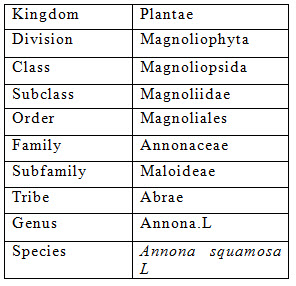
SYNONYMS (Sandeep et al., 2017)
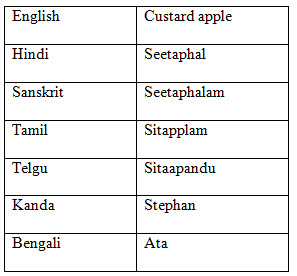
MICROSCOPICAL STUDIES (Agrawal M et al., 2011)
Leaf: Annona squamosa leaf is dorsiventral. Single layer of palisade cells are present below upper epidermis. Paracytic types of stomata found in lower epidermis. Mesophyll contains 3-4 layers of spongy parenchyma with many intercellular spaces. The midrib portion shows collenchyma below epidermis on both surfaces. In between collenchymatous and vascular bundle there are parenchymatous cells. The vascular bundle composed of lignified phloem & xylem arranged in collateral-open type. Sclerides are present below collenchymatous cells of upper epidermis.

FIGURE I: Transverse section of Leaf
STEM:
Transverse section of stem shows that collenchymatous cells present below epidermis, which followed by pericyclic fibers, phloem (food conducting vessels), xylem (water conducting vessels) & parenchymatous cells. Xylem is surrounded by pith & starch grains which contains lignified stone cells. Starch grains are of ellipsoid or oval shaped, if treated with iodine solutions turns to blue in colour.
MACROSCOPICAL STUDIES OF LEAF & FRUIT (Patel J et al., 2008)
LEAF:
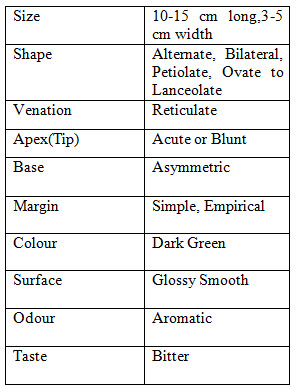
FRUIT (Pandey V.K et al., 2014)
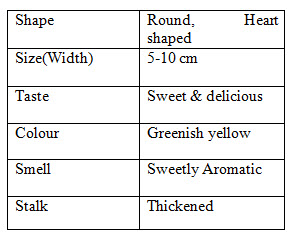
CLIMATE CONDITIONS &CULTIVARS (Morton J. F et al., 1987)
The custard apple requires a tropical climate but with a cooler winters than those of west Coast of Malaya. It gets proliferates in coastal lowlands of Ecuador; is quit above 5,000 ft (1500m). In Guatemala- nearly found below 4,000 ft (1,220m). In India-it does well from the plains up to an elevation of 4,000 (1,220m); In Ceylon-it cannot be grown above 3,000 ft (915m). It is much below 2,600 ft (800m) in Philippine. It is mild for California & trees introduced into Palestine succumbed to the cold. In southern Florida the trees still dormant all over the winter season & leaves are employed as shed at the beginning of Cold Weather. Fully grown, it has survived temperature of 27 ͦ to 28 ͦ F without any serious harm.
No named cultivars are reported but there is considerable fluctuation in the quality of fruit from different trees. The yellow-skinned type seems high quality than brownish, when well filled out, have thicker and juicer flesh. Seeds of purple-skinned, purple-fleshed form, from Mexico, were planted in Florida and the trees yielded fruit of unremarkable quality.

Figure II: Custard apple tree
NURTITIONAL VALUE (Shrinivasan P et al., 2015)
100 gm of edible portion of the fruit Amount per serving:
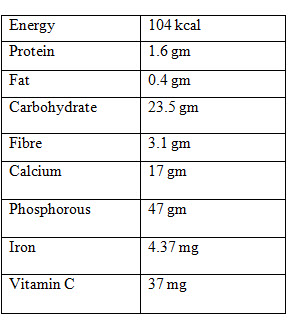
TRADITIONAL USES:
LEAVES:
When bruised, are applied for extraction of guinea-worm (Patel J et al., 2008) and when reduced to powder, are used to kill lice on cattle. It is used in the treatment of hysteria (Wildness), fainting spells (Sudden or temporary loss of consciousness), anal prolapse. It has limited use in perfumery. They are also applied on ulcer, wounds and leaf decoction used in case of dysentery.
ROOT:
They have been applied as purgative, in treatment of dysentery, spinal marrow disease & diabetes.
FRUIT:
Crushed ripe fruit is mixed with salt, is applied on tumour. Preparation shows actions as astringent, haematic, cooling, expectorant and in treating anaemia and burning sensation.
Fresh fruit pulp is utilized as flavouring agent for ice cream and milk beverages. Food product such as Jam, squash are also made from pulp and wine manufacturing (Vyas K et al., 2012).
According to Ayurveda, fruit is regarded as a good tonic. Helpful in increasing muscles strength & enriches blood (Chenyao M et al., 2017).
BARK:
Bark is powerful astringent and toxic (Gowdhami M et al., 2014). Bark decoction given as a tonic to prevent diarrhoea, anticancer. Fibre extracted from the bark has been employed for cordage.
SEED:
It shows effects as anti-inflammatory, hypotensive, extract defatted seeds showed antitumor and central analgesic activity, haemolysis of red blood cells and is a fish poison. Seed has abortifacient action and used in eliminating lice present in hairs if seeds are mixed with gram flours, is excellent remedy for hair wash treatment (Chinghai M et al., (2017).
TREE:
Serve as a host for lac-excreting insects. Tree is grown in gardens as ornamental tree, it is recommended as good source of firewood (Vyas K et al., 2012).
IMPORTANT PARTS OF ANNONA SQUAMOSA (BASU .B.D et al., 1984)
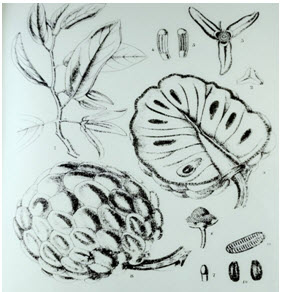
PHYTOCHEMICAL INVESTIGATION:
LEAVES:
Leaf oil yielded 59 chemical compounds. Leaves yield excellent oil rich Terpenes and Sequeterpenes mainly β- caryphyllene (31.1%), δ- cardionene, α-murolene (5.5%), α cardinal (4.3%) (Kaur R et al., 2015).
Leaves gave isoquinoline alkaloids. Two acetogenine, annoreticulin and isoannoreticuin isolated from leaves, were found to be selectively cytotoxic to certain human tumours.
Leaves and stems gave alkaloid dopamine, salsolnol, coclaurine. It contain Borneol, Camphor, Carvone, Eugenol, Farnesol, Geraniol, Limonene, Linalool, Menthone(Patel J et al.,2008) & atrophine, roemerine, norisocoryline and sugars like rhamnoside and quercetin-3-glycoside.
ROOT AND STEM (Bhattachary A et al., 2016)
Root & stem extract reported to contain different chemical constituents like Borneol, Camphene, Camphor, Carvone, β caryphyllene, Eugenol, geraniol, 16-Hetricontanone, Hexacontanol, Higemamine, isocorydine & limonene (Bhattachary A et al., 2016).
Six new ent-kaurane diterpenoids annomosin A, annosquamosin C, annosquamosin D, annosquamosin E, annosquamosin F, annosquamosin G were isolated from stem of Annona squamosa (Pandey N et al., 2011)
BARK:
Stem bark showed the presence of Bullatacin. It contains compounds like N-Nitrosoxylopine, Roemerolidine, Duguevalline (Saha R et al., 2011). Also mosinone-A, mosin-B, mosine-C, squamone isolated from bark (Sandeep et al., 2017).
FRIUT:
Fruit provided 12 known kaurane derivatives and 2 new kaurane diterpenoids such as annosquamosin-A and annosquamosin-B.
PARMACOLOGICAL ACTIVITY:
• Antimalarial Activity
• Antioxidant Activity
• Antiulcer Activity
• Antimalarial Activity
• Antidiabetic Activity
• Insecticidal Activity
• Anti-inflammatory Activity
• Antimicrobial Acctivity
• Antibacteriel Activity
ANTIMALARIAL ATIVITY (Tylor J et al., 2011)
In recent study it reveals that alkaloid Aporphine isolated from bark of Annona squamosa are Roemerolidine, N-Nitroxylopine and Duguevalline are subjected for antimalarial activity (Saha R et al., 2011).
The all compound found in Annona squamosa showed moderate antiplasmodial activity against chloroquine resistant strain (Dd2) and chloroquine sensitive strain (D10).
Plant represent an important source of novel antimalarial compound as most famously evidenced by the antimalarial agent quinine and artemisinin initially isolated from chinchona species.
ANTIDIABETIC ACTION (Pandey N et al., 2011)
Present study reported that the Antihyperglycemic activity of root extract was carried out by inducing Streptozocin (STZ) in Albino wistar rat with diabetes mellitus and insulin deficiency.
The study resulted that oral administration of Annona squamosa aqueous extract to diabetic rats for 30 days significantly reduced blood glucose, urea, uric acid and creatinine, but increased the activity of insulin peptide, albumin, globulin ratio and restored all marker enzymes to near control level.
ANTIULCER ACTIVITY (Win M. O et al., 2017).
Annona squamosa twigs contain active constituents as (+)-O-methylarmepavine, N-methylcorydaldine and isocorydine have antisecretory property which protect from peptic ulcer.
It reduces gastric acidity, pepsin and gastrin level and inhibits H+-k+ ATPase pump.
In the same manner, leaf extract was shown to be protective against aspirin plus pyloric ligation induced ulcer in mice.
ANTIOXIDANT ACTIVITY (Kaur R et al., 2015)
The antioxidant activity in mature fruit of 36 species and varieties produced in Taiwan was evaluated by Ferric Reducing Antioxidant Powder (FRAP) assay.
Many studies conducted in India showed that extract of Annona squamosa, Annona cherimola and Annona muricata have high Antioxidant activity.
INSECTICIDAL ACTIVITY (Kumar A et al., 2010)
The insecticidal activity appears to be due to presence of active principles found in leaf of Annona squamosa. The extract of this plant being a contact poison for insect can penetrate the body wall and tracheal system leading to death probably lending the extract the insecticidal activity against Sitophilus oryzae. The plant derived toxicants employed as an insecticide may allow a reduction in the health hazards of synthetic pesticides and the high degree of insecticidal activity seems to confirm the traditional claims for this herb.
ANTIINFLAMMATORY ACTIVITY (Hemalatha K et al., 2009)
Anti-inflammatory activity was evaluated using carrageenan-induced hind paw edema method. Carrageenan (0.1 ml of 1% suspension) was injected sub plantar tissues of the right hind paw of each rat. It is the phlogistic agent used to test anti-inflammatory drugs as it is regarded to be antigenic and is devoid of systemic effects. Inflammatory mediators like histamine & serotonine (Initial phase) kinin (middle phase) and prostaglandins (final phase after 3-5 hours injection of carrageenan) gets released which play an important role in the development of inflammation.
NOW YOU CAN ALSO PUBLISH YOUR ARTICLE ONLINE.
SUBMIT YOUR ARTICLE/PROJECT AT editor-in-chief@pharmatutor.org
Subscribe to Pharmatutor Alerts by Email
FIND OUT MORE ARTICLES AT OUR DATABASE
HEALTH BENEFITS (Kokate S et al., 2014)
• Good for better foetal brain development
• Natural antidote for morning sickness
• Good for skin rejuvenation
• Naturally heals the skin infections
• Delays aging and keeps the skin youthful
• Keep skin cancer away
• Good for pimple prone skin
• Helps to eliminate lice
• For better collagen level
• Natural detoxifying agent
• Moisturises hairs reduces Pigmentation problems
• To relieve dysentery, cold flu
• Decoction from leaves promote healthy blood flow during Menstrual cycle in women
• Leaves paste help in wound healing
• Useful in anemia
• Alleviate rheumatic pains
• For a better vision
• For a better cardiovascular health
• Prevent premature labour
• For a better brain health
• Prevent from microbial attack
CONCLUSIONS & FUTURE PROSPECTIVE:
Annona squamosa is commonly known as custard apple or sugar apple. The plant has various medicinal properties & has its own folkoric importance. The plant is extensively used traditionally for curing many diseases & disorders. The plant is widely cultivated in tropical & subtropical area of world. The plant has been reported to contain various active principles having specific pharmacological activities such as Anti-inflammatory, Analgesic, Insecticidal, Antiulcerative, Antitumor, Antimalarial, Antioxidants. The studies performed on the seed extract show evidence against Anti-HIV Activity. Reasearch on phytoconstituents present in Annona squamosa has gained a special attention in recent times as it posseses challenging activities. The plant is to be considered as god worship to all humankind from Ayurveda & requires well defined systematic approach for better exploitation in future.
REFERENCES:
1. Agrawal M., Agrawal Y., Itankar P., Patil A., Kelkar A., Vyas J(2011); Pharmacognostical Evaluation of Annona squamosa Linn; Int J of phytomedicine; 3(3); 480-485.
2. B. D. BASU, Kirtikar(1984) INDIAN MEDICINAL PLANTS; Bishen Singh Mahendra Pal Singh; Dehradun, India.
3. Bhattachary A., Chkraverty R(2016); The pharamacological properties of Annona squamosa Linn: A Review; IJPE; 4(2); 692-699.
4. Chinghai M., Yamuna C., Xian Li., Yang C (2017); A Review on Annona squamosa L.: Phytochemical & Biological Activities; 45(5):933-964
5. Gowdhami M., Sarkar B.L., Ayyasamy (2014); Screening of phytochemicals and Antibacterial Activity of Annona Squamosa Extract; ijpsi; 3(7); 30-39.
6. Hemalatha K., Satyanarayana D(2009); Anti-inflammatory activity of Annona squamosa Linn; Biomed. & Pharmacol. J; 2(1); 18-20.
7. Julia F. Morton (1987) Custard Apple In: Fruits of warm climates; Creative Resource systems, Inc.; Winterville N. C.
8. Kalidindi N., Kalidindi B., Thimmaiah N., Nagepally J., Rakaia N., Swathe S et al., (2015); Antifungal and antioxidant activities of organic and aqueous extracts of Annona squamosa Linn. Leaves; JFDA ; 23(4); 1-8.
9. Kaur R., Kaur K., Kaur P., Singh I(2015); SITAPHAL:UNEXPLORED THERAPEUTIC POTENTIAL; AJPSci; 3(4); 129-140.
10. Kokate, S(2014), “Amazing healing powers of Custard Apple”,paper presented in PPRC Conference, 15 december Avilable at: www.researchgate.net/publication/269519313.
11. Kumar A., Rekha T., Devi Shymala., Kannan., Jaswanth A., Gopal V(2010); Insecticidal Activity OF Ethanolic Extract of Leaves Of Annona sqamosa; J.Chem.Pharm. Res; 2(5); 177-180
12. Pandey N., Barve D(2011); Phytochemical & Pharmacological Review on Annona squamosa Linn; J Pharm Biomedical sic; 2(4); 1404-10
13. Pandey V.K., Giri I.C., Prakashdeep., Singh S., Srivastava A(2014); Pharmacognostical & Physicochemical study on the leaves of Annona squamosa Linn; Int J Res pharm sic ;4(2); 8-12.
14. Patel J., Kumar V(2008); Annona squamosal L Phytochemiocal Analysis & Antimicrobial Screening; J Pharm Res; 1(1); 34-38.
15. Saha R(2011); Pharmacognosy and Pharmacology of Annona squamosa: A review; Int. J. of Pharm & Life Sci 2(10); 1183-89.
16. Sandeep., Mittal A(2017); Annona squamosa: Seetaphal: A Review; IJCAP; 2(3); 72-81.
17. Shrinivasan P(2015); Sitaphal : Reemergence; RJPBCS; 6(3); 1560-1565.
18. Tylor J., Arnold W., Jurgens T., Mansor S., (2011); Antimalarial alkaloids isolated from Annona squamosa; phytopharmacology ; 1(3); 49-53.
19. Vyas K., Manda H., Sharma R., Singhal G(2012); AN UPDATE REVIEW ON ANNONA SQUAMOSA; IJPT; 3(2); 107-118.
20. Win M. O., Myat M. K(2017); Pharmacological Activities of Annona squamosa: Update Review; IJPC; 3(6); 86-93.
|
PharmaTutor (Print-ISSN: 2394 - 6679; e-ISSN: 2347 - 7881) Volume 7, Issue 01 Received On: 28/11/2018; Accepted On: 12/12/2018; Published On: 01/01/2019 How to cite this article: Narwade, D. and Aher, A. 2019. A Review on: Phytochemical and Pharmacological Study of Annona Squamosa. PharmaTutor. 7, 1 (Jan. 2019), 5-10. DOI:https://doi.org/10.29161/PT.v7.i1.2019.5. |
NOW YOU CAN ALSO PUBLISH YOUR ARTICLE ONLINE.
SUBMIT YOUR ARTICLE/PROJECT AT editor-in-chief@pharmatutor.org
Subscribe to Pharmatutor Alerts by Email
FIND OUT MORE ARTICLES AT OUR DATABASE









